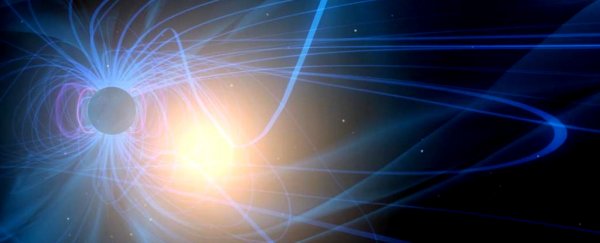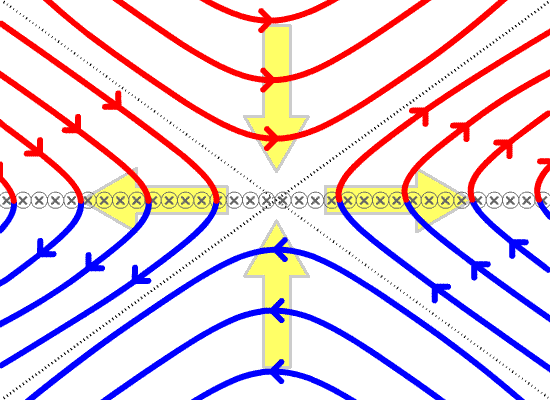Researchers have proposed a new solution to a mystery that has puzzled the physics world for decades - how are solar flares, gamma-ray bursts, and the Northern Lights triggered so rapidly?
That's an important question, seeing as solar flares can interrupt communication on Earth, and gamma-ray bursts can wipe us out without any warning. And now scientists think they might finally have an answer.
We already know that all those high-energy phenomena occur thanks to something called magnetic reconnection, which occurs when magnetic field lines come together, snap apart, and explosively reconnect.
But until now, physicists haven't been able to figure out how it can happen so damn fast.
You can see a demonstration of magnetic reconnection below:
The magnetic field lines you can see in red and blue above are embedded in plasma - the hot, charged gas that makes up 99 percent of the visible Universe.
According to our current understanding, the process of magnetic reconnection takes place in thin sheets of plasma, where electric current is highly concentrated.
So far, so good. The problem is that we've observed magnetic reconnection happening much faster than we can explain. Our current understanding suggests that these plasma sheets can be very elongated, which means that they should be slowing magnetic reconnection down.
Now a team of researchers from Princeton University has come up with a detailed hypothesis for how this fast reconnection can work, without breaking the laws of physics.
If it turns out to be correct, it could help us better forecast space storms, explain some of the weird magnetic behaviour we see going on in the Universe, and even help us more efficiently contain nuclear fusion reactors.
The new hypothesis is based on something called plasmoid instability.
According to plasmoid instability, those thin, elongated sheets of plasma are broken down into small magnetic islands called plasmoids - which means the magnetic field lines can move as fast as they need to.
Plasmoid instability has previously been suggested as an explanation for how fast magnetic reconnection works, but until now, no one had been able to figure out exactly what this instability is, and how it occurs.
Now, for the first time, the Princeton researchers have written up a 'general theory of the plasmoid instability'.
Their research suggests that plasma sheets do start out in a linear phase - which keeps magnetic reconnection slow - but they then shift into an explosive phase, which dramatically increases the speed of magnetic reconnection.
The team has been able to calculate in detail exactly how long each of these periods last, and the complex physics behind it, which you can read more about in their paper in Physics of Plasma.
Surprisingly, the team showed that the plasmoid instability doesn't obey traditional power laws - which is where one quantity varies as a power of another.
In other words, changing plasmoid instability didn't change magnetic reconnection in a predictable way - which is something the team still doesn't fully understand.
"It is common in all realms of science to seek the existence of power laws," the team writes. "In contrast, we find that the scaling relations of the plasmoid instability are not true power laws - a result that has never been derived or predicted before."
This new hypothesis still needs to be tested by independent teams before we can say for sure that this is how plasmoid instability works - or even that it's behind fast magnetic reconnection.
But we're now one step closer to understanding the trigger of some of the most violent events in the Universe, and that's pretty cool.

